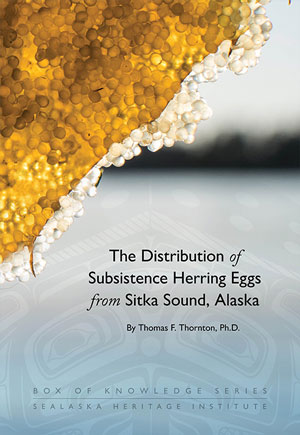
New Study calls on state to reform management of Sitka Sound roe fishery
November 21, 2019
The study, The Distribution of Subsistence Herring Eggs from Sitka Sound, Alaska, touts the enormous, wide-ranging social and ecological benefits of Pacific herring from Sitka Sound and the unique Alaskan subsistence economy and ecosystem services which depend on their production and distribution.
The study, which was sponsored by Sealaska Heritage Institute (SHI) and led by Investigator Thomas Thornton, Ph.D., found that spawning populations of herring outside of Sitka Sound have been depleted by commercial reduction and sac roe fishing and that the role of Sitka herring as a keystone subsistence resource and foundation forage fish for salmon, sea mammals and other fish and wildlife in the marine food web should be a matter of public policy concern, review and reform. The study included interviews with more than 50 participants from Sitka, Angoon, Hoonah, Kake, Juneau, Metlakatla and other communities involved in the subsistence harvest and distribution of herring roe. The study was also based on a thorough review of the scientific literature and previous research efforts of the investigator. It is one of the most extensive studies of its kind on the cultural, historical and societal importance of herring in Sitka Sound, the mecca of herring spawning and egg gathering for thousands of years and the last stronghold in the region of this keystone species. The importance of the study and its findings cannot be overstated, said SHI President Dr. Rosita Worl, an anthropologist who has studied subsistence cultures and economies throughout Alaska and the circumpolar Arctic. “We in the Native community have said for many years that our herring runs are in trouble, but our pleas have fallen on deaf ears, even as we’ve witnessed once-strong herring runs disappear,” said Worl, noting that herring populations once abounded across Southeast Alaska. “If the current management approach continues, we will see the extinction of another cultural tradition, to the detriment of all Alaskans, herring and the species that rely on herring,” said Worl, who authored the foreword for the publication. The study argues that improved recognition and support for the ecological and cultural benefits of Native herring egg gathering and cultivation techniques, and an alternative approach to the destructive sac-roe extraction fishery, is the best way to optimize benefits to Alaskans and the health of the state’s fisheries. Among other things, the study recommends that the state, which does not recognize herring as a forage fish, add the species to Alaska’s Forage Fish Management Plan, which might subject the fish to more conservative conservation management. “Pretending, by omission, that they are not a forage fish is a scientific and legal absurdity. Herring are classified as forage fish by most government agencies, including the United States Geological Survey and the National Oceanic and Atmospheric Administration,” Thornton wrote, citing a paper compiled by the Sitka Tribe of Alaska. The study also recommends that the state commission a management evaluation to improve the stewardship of Pacific herring. The management evaluation should recognize the historical and cultural ecology that has served to develop and sustain the model of “cultivated abundance,” as opposed to the “maximum sustained yield” model the state uses today. The evaluation should factor in Indigenous herring management, as well as the unparalleled distributional system and ecocultural benefits, Thornton wrote. The study also recommends that the state change the way herring roe is allocated for subsistence harvests. The current method, known as “amount necessary for subsistence,” grossly underestimates the amount needed for subsistence use. In addition, the study recommends instituting a robust collaborative research and management regime under a memorandum of agreement that would include the Alaska Board of Fisheries, the Alaska Department of Fish and Game, Sitka Tribe of Alaska and the Federal Subsistence Regional Advisory Council for Southeast Alaska. Under the new structure, the partners would work together on a strategic review and revised guidelines for management of herring ecosystems. The author will give a lecture on the topic at noon on Tuesday, Nov. 26, at Sealaska Heritage, 105 S. Seward St. in Juneau. SHI is taking preorders for the book, which will be available through the Sealaska Heritage Store. The book, which is part of SHI’s Box of Knowledge series, is based on extensive study of the subsistence and commercial herring roe and reduction fisheries. The story begins with the origins of roe harvests. Dr. Thomas Thornton, currently dean of arts and sciences and vice-provost for research and sponsored programs at the University of Alaska Southeast, has carried out human ecological studies in Alaska and elsewhere for more than 30 years. His book, Haa Léelk’w Hás Aaní Saax’u: Our Grandparents’ Names on the Land, which was published by Sealaska Heritage Institute with the University of Washington Press, won a 2012 Alaska Historical Association award. In previous Alaska research he has collaborated with numerous Southeast Alaska tribes and organizations, including Sitka Tribe of Alaska and the Southeast Native Subsistence Commission. While carrying out this study, he served as an associate professor and senior research fellow at University of Oxford’s Environmental Change Institute, School of Geography and the Environment, United Kingdom. SHI launched its Box of Knowledge series to encourage scholarship on Tlingit, Haida and Tsimshian cultures, to disseminate papers and research more widely and to circulate work that has not been published.
Edited by Mary Kauffman, SitNews
Source of News:
|
||||
